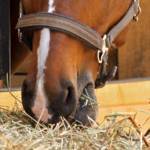Benefits of Late-Cut Hay for Horses

As the warm summer months draw to a close, horse owners are likely stocking up on hay for the winter. Hay dealers typically offer a variety of hays, including the yellowish or brownish varieties that might have been harvested past their prime. Although this hay might not be as green as hay baled under optimal conditions, there are many benefits to late-cut hays.
Did you know these facts about late-cut hays?
- Late-cut hays have less water-soluble carbohydrates (i.e., glucose, sucrose, fructose, and fructans) and are therefore better for obese, insulin dysregulated horses, and those diagnosed with equine metabolic syndrome.
- They have more structural carbohydrates that are fermented in the large intestine to provide energy in the form of volatile fatty acids (e.g., lactate, acetate).
- Late-cut hays can provide enough energy and nutrients (i.e., carbohydrate, protein, minerals, vitamins, etc.) for most horses to thrive, even if pregnant, lactating, or exercising.
- They sometimes contain fewer weeds than early-cut hay.
Regardless of what hay type is ultimately selected, follow the basic rules for selecting good-quality hay. For example, never feed moldy or dusty hay to horses, particularly those with respiratory issues, and do not feed hay with blister beetles or hay rife with other bugs or debris. Be aware that not all hays and horses marry well—high-energy hay, such as high-quality alfalfa, might be great for exercising horses but not for elderly geldings or retired broodmares.
Additionally, all hays vary depending on the weather conditions in which they were grown and harvested. This means that every type and cut, even if harvested from the same field, can vary markedly in nutritional content. This is where hay analysis comes in handy, as it provides a readout of the forage’s nutritional content. Hay analysis may also benefit horses thought to have insulin dysregulation or equine metabolic syndrome. If the hay is high in water-soluble carbohydrates, soaking hay can remove those excess carbohydrates.
In short, choose your hay wisely, preferably with the assistance of an equine nutritionist or a knowledgeable horseperson.








